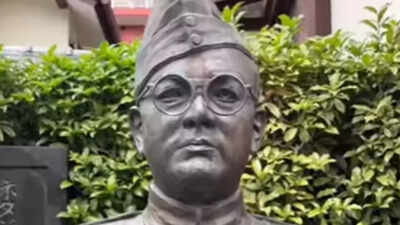ARTICLE AD BOX

Credit: Instagram/@shige_japaniguruji
Tucked away in a quiet corner of Tokyo’s Suginami Ward stands Renkō-ji Temple—a modest, centuries-old Buddhist shrine that has quietly drawn visitors, questions, and emotions for nearly eight decades.
Far from a tourist hotspot, this unassuming temple holds an object of immense historical significance and emotional gravity: an urn said to contain the ashes of Netaji Subhas Chandra Bose, one of India’s most enigmatic freedom fighters. And with it, Renkō-ji cradles a mystery that continues to haunt Indian memory: did Bose really die in that 1945 plane crash?
From revolution to reverence: Bose’s Japan connection
Subhas Chandra Bose remains a towering figure in India’s independence movement, celebrated for his uncompromising stance against British rule and his leadership of the Indian National Army (INA).
Unlike Mahatma Gandhi’s path of non-violence, Bose believed liberation required force. During World War II, he forged alliances with Nazi Germany and Imperial Japan in hopes of toppling British colonial power.

Credit: iStock
In 1943, Bose arrived in East Asia, rallying the INA under Japanese sponsorship and setting his eyes on India through Burma. But after Japan’s surrender in August 1945, the tide turned. Official accounts claim Bose died on August 18, 1945, after his Japanese military aircraft crashed in Taipei.
Badly burned, he was said to have died two days later, and his remains were cremated and brought to Japan. On September 14, 1945, his ashes were entrusted to the Tokyo Indian Independence League and placed in Renkō-ji Temple following a memorial service.
A shrine, a mystery, a memory
Renkō-ji Temple was established in 1594 and belongs to the Nichiren sect of Buddhism. Unlike the grand shrines of Kyoto or the iconic temples of Tokyo, Renkō-ji is serene and simple—its architecture quiet, its grounds humble.
Yet it holds a significant legacy.At the center of its courtyard stands a bronze bust of Netaji, installed in 1975. Flanked by plaques marking visits from Indian dignitaries—Jawaharlal Nehru in 1957, Indira Gandhi in 1969, Atal Bihari Vajpayee in 2001, and others—the site becomes a place of pilgrimage every August 18, when the temple opens for a memorial service marking Bose’s reported death anniversary. Inside the main hall, a small golden pagoda holds the urn said to contain his ashes.
For the rest of the year, Renkō-ji remains closed to the public, adding to the enigma that surrounds it.
Contested remains and unanswered questions
But here’s where reverence meets controversy. The authenticity of the ashes has long been disputed. While Japanese records and commissions like the 1970 G.D. Khosla Commission affirm Bose’s death in the crash, the 2005 Mukherjee Commission disagreed, concluding there was no conclusive evidence Bose died in Taiwan.
The Indian government dismissed the Mukherjee findings without explanation, keeping the debate alive.Theories about Bose’s fate abound—some claim he escaped to the Soviet Union, others suggest he lived in secrecy in India. Family members, including his daughter Anita Bose Pfaff and grandnephew Chandra Kumar Bose, have repeatedly called for DNA testing of the remains. In a 2005 letter, Renkō-ji’s then-chief priest confirmed the temple’s willingness to permit testing.
Yet no test has been conducted, and as of 2025, the ashes remain undisturbed.

Credit: iStock
Visiting Renkō-ji: A quiet pilgrimage
Located about 500 meters from Higashi-Koenji Station, Renkō-ji isn’t easy to stumble upon. Hidden in a residential neighborhood and absent of English signage, it’s not on most Tokyo travel itineraries. Those who make the journey often describe it as a profoundly emotional experience. Through Sanshi-no-Mori Park and into the temple courtyard, visitors are greeted not with fanfare, but with solemnity.The priests’ decades-long guardianship of the ashes—now upheld by Nichiko Mochizuki, the son of Reverend Kyoei Mochizuki—adds a layer of reverence not often seen in global shrines to foreign figures.
A legacy awaits closure
Despite public interest, political visits, and continued family appeals, no Indian government has made a formal request to repatriate the remains. The Japanese government and temple custodians have signaled their willingness, but the silence from New Delhi remains deafening.In the heart of Tokyo, far from Netaji’s birthplace in Cuttack or the battlegrounds of Southeast Asia, Renkō-ji Temple keeps vigil. It holds not just an urn, but a story unfinished—a story of courage, of freedom, and of a nation's unanswered question.



.png)
.png)
.png)
















 14 hours ago
5
14 hours ago
5









 English (US) ·
English (US) ·